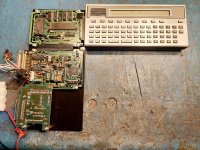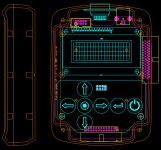taylorjpt
Experienced Member
- Joined
- Oct 25, 2023
- Messages
- 75
I Found what I hope is a source for a CE-158 serial interface so that I can get one to wring out the operational details in person. Been looking for one on Ebay etc but they are very rare, however a company in Germany has new ones available; at least it appears that they do since they let me order and pay ($500) for one!
My target BOM is still $10 with a minimum amount of coding (I don't need to know what's in the original ROM, I just need to provide it for the PC2). To get the cost down I'm using an SRAM in place of the ROM that the PC2 draws upon to run the serial interface. The SRAM will get loaded from my controller flash and then have the WE# locked high and the data/address bus floated. I'll only have to do this once so long as the battery stays up.
Won't be limited to 2400 baud as that is a HW limit of the original device. I can run at the PC2 demanded rate or manually select anything up to 1MBaud which is the limit of the RS232 driver chips, i.e. PC2 says 2400 but I feel like 115,200. The controller and SRAM will be the same as my RAM expanders and cassette emulator, even pulled in the cassette LIPO charger that has been working great. The PC2 does not do any of the actual SERDES so it does not have to know the bits are coming it at a million per second... the interrupt handshaking will abstract that all away.
For even more fun, I can pull in the flash file system from the cassette emulator to store programs on the serial interface... no need to decide now as I can just DNI the 16MB worth of flash to begin with.
1. True RS232 interface using Max232 for the +/-7V
2. Logic level UART interface
3. USB serial interface
4. Hardware flow control with bidirectional data buffering in the controller, 1kB each way
5. 32K SRAM ROM emulator
6. 16MB of on board flash
7. Centronics port (Because why not?!)
8. LiPo battery for stand alone operation
9. In sleep my controller operates at the raw LIPO voltage at about 50uA but then boosts it up to 5V to talk to the PC2.
Should be able to spin the PWB within 2 days of getting my CE-158. There is a crisp CE-158 schematic in the ether that cleared up a lot of questions
Schematic is done, just waiting for confirmation of the plan after my original unit comes in and I hook up my logic analyzer.
My target BOM is still $10 with a minimum amount of coding (I don't need to know what's in the original ROM, I just need to provide it for the PC2). To get the cost down I'm using an SRAM in place of the ROM that the PC2 draws upon to run the serial interface. The SRAM will get loaded from my controller flash and then have the WE# locked high and the data/address bus floated. I'll only have to do this once so long as the battery stays up.
Won't be limited to 2400 baud as that is a HW limit of the original device. I can run at the PC2 demanded rate or manually select anything up to 1MBaud which is the limit of the RS232 driver chips, i.e. PC2 says 2400 but I feel like 115,200. The controller and SRAM will be the same as my RAM expanders and cassette emulator, even pulled in the cassette LIPO charger that has been working great. The PC2 does not do any of the actual SERDES so it does not have to know the bits are coming it at a million per second... the interrupt handshaking will abstract that all away.
For even more fun, I can pull in the flash file system from the cassette emulator to store programs on the serial interface... no need to decide now as I can just DNI the 16MB worth of flash to begin with.
1. True RS232 interface using Max232 for the +/-7V
2. Logic level UART interface
3. USB serial interface
4. Hardware flow control with bidirectional data buffering in the controller, 1kB each way
5. 32K SRAM ROM emulator
6. 16MB of on board flash
7. Centronics port (Because why not?!)
8. LiPo battery for stand alone operation
9. In sleep my controller operates at the raw LIPO voltage at about 50uA but then boosts it up to 5V to talk to the PC2.
Should be able to spin the PWB within 2 days of getting my CE-158. There is a crisp CE-158 schematic in the ether that cleared up a lot of questions
Schematic is done, just waiting for confirmation of the plan after my original unit comes in and I hook up my logic analyzer.



